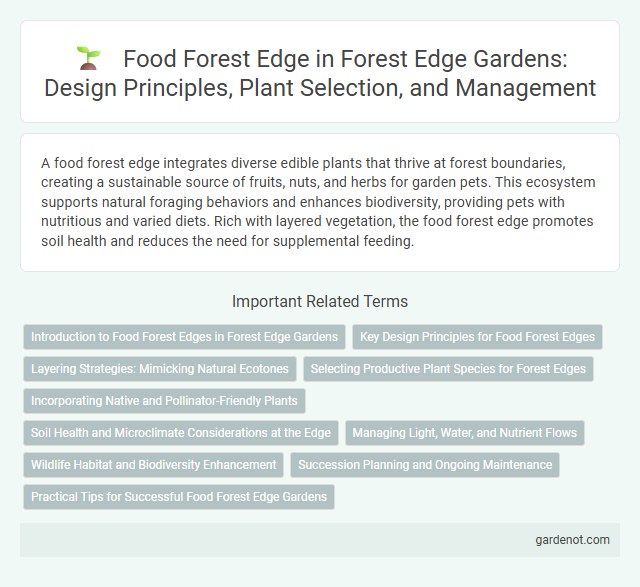A food forest edge integrates diverse edible plants that thrive at forest boundaries, creating a sustainable source of fruits, nuts, and herbs for garden pets. This ecosystem supports natural foraging behaviors and enhances biodiversity, providing pets with nutritious and varied diets. Rich with layered vegetation, the food forest edge promotes soil health and reduces the need for supplemental feeding.
Introduction to Food Forest Edges in Forest Edge Gardens
Food forest edges in forest edge gardens serve as dynamic zones where diverse plant species interact, enhancing biodiversity and boosting ecosystem resilience. These edges optimize sunlight exposure and microclimate conditions, promoting vigorous growth of edible plants such as fruit trees, shrubs, and perennial vegetables. Incorporating multi-layered vegetation structures, food forest edges improve soil health, conserve water, and provide abundant, sustainable food yields.
Key Design Principles for Food Forest Edges
Food forest edges maximize biodiversity by integrating diverse plant layers, including ground covers, shrubs, and nitrogen-fixing trees, to create a resilient ecosystem. Implementing key design principles such as species selection for complementary growth, effective sunlight management, and strategic planting patterns enhances soil fertility and optimizes microclimates. These edges serve as vital habitats for pollinators and beneficial insects, promoting natural pest control and sustainable food production.
Layering Strategies: Mimicking Natural Ecotones
Food forest edge design employs layering strategies that mimic natural ecotones by integrating multiple vegetation strata, including canopy trees, shrubs, herbaceous layers, and ground covers. This approach maximizes biodiversity and resource use efficiency, fostering resilient plant communities that support abundant food production. By replicating edge effects found in natural forests, food forest edges enhance nutrient cycling, microclimate regulation, and habitat diversity for beneficial insects and wildlife.
Selecting Productive Plant Species for Forest Edges
Selecting productive plant species for food forest edges maximizes biodiversity and yields by combining shade-tolerant perennials like hazelnuts, elderberries, and medicinal herbs. Choosing deep-rooted nitrogen-fixing plants such as autumn olive enhances soil fertility while supporting beneficial insects and pollinators. Integrating fast-growing fruit trees with berry shrubs creates layered plantings that optimize sunlight capture and space efficiency along forest boundaries.
Incorporating Native and Pollinator-Friendly Plants
Incorporating native and pollinator-friendly plants at the food forest edge enhances biodiversity and strengthens ecosystem resilience. Species such as Echinacea purpurea, Asclepias syriaca, and Ceanothus americanus provide essential nectar and pollen sources for native bees, butterflies, and hummingbirds. This strategic plant selection fosters natural pest control and improves fruit yields by supporting vital pollinator populations.
Soil Health and Microclimate Considerations at the Edge
Food forest edge zones enhance soil health through diverse root systems that improve soil structure, increase organic matter, and promote beneficial microbial activity. These edges create unique microclimates by moderating temperature extremes, reducing wind exposure, and retaining moisture, which supports plant resilience and biodiversity. Integrating nitrogen-fixing plants and mulch layers further stabilizes soil nutrients and fosters a thriving ecosystem at the forest boundary.
Managing Light, Water, and Nutrient Flows
Managing light, water, and nutrient flows in a food forest edge enhances plant growth and productivity by optimizing resource use. Strategic layering of vegetation maximizes sunlight exposure while creating shade zones that reduce water evaporation and protect nutrient-rich soil. Implementing swales and mulching techniques improves water retention and nutrient cycling, supporting diverse, resilient plant communities.
Wildlife Habitat and Biodiversity Enhancement
Food forest edges create vital wildlife habitats by providing diverse plant species that attract pollinators, birds, and beneficial insects. These ecotones enhance biodiversity through layered vegetation structures, offering food, shelter, and nesting sites essential for various animal species. Integrating native trees, shrubs, and ground covers fosters ecological balance and supports resilient ecosystems at the forest boundary.
Succession Planning and Ongoing Maintenance
Food forest edge succession planning involves strategically selecting plant species that mature at different rates to ensure continuous productivity and ecosystem resilience. Implementing ongoing maintenance practices such as pruning, mulching, and soil health monitoring promotes sustainable growth and prevents invasive species from encroaching. Regular assessment of plant health and adaptive management techniques support long-term stability and productivity of the forest edge ecosystem.
Practical Tips for Successful Food Forest Edge Gardens
Plant diverse layers including canopy trees, shrubs, ground covers, and root crops to mimic natural forest edge ecosystems that optimize space and nutrient use. Select native and climate-adapted species to enhance resilience against pests and environmental stresses, ensuring sustainable growth. Regularly mulch and manage soil health with organic matter to maintain moisture, suppress weeds, and foster beneficial microbial activity for a productive food forest edge garden.
Food forest edge Infographic

 gardenot.com
gardenot.com